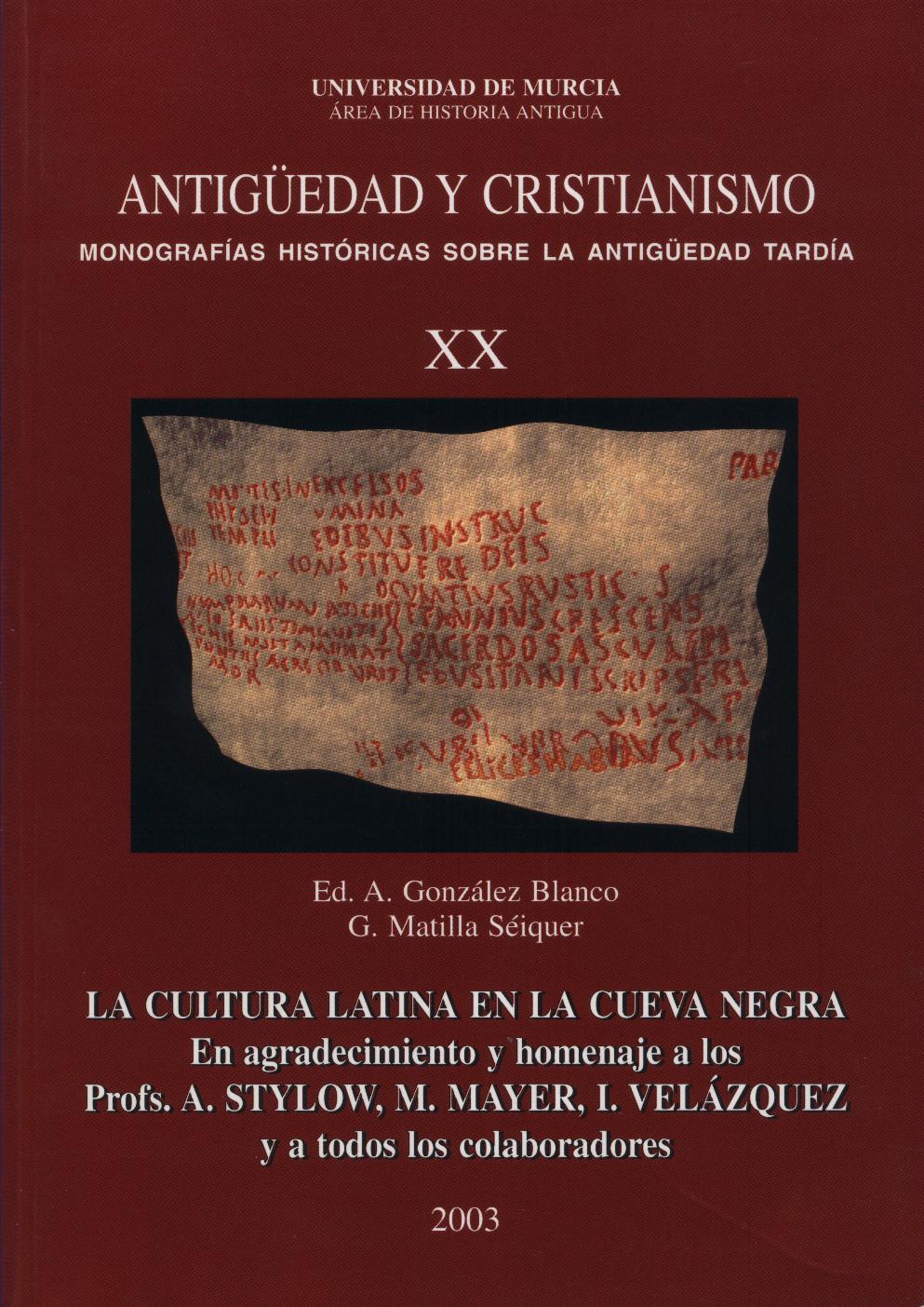El culto a Baco en la religión romana y los textos de Fortuna (Murcia)
Abstract
In the texts from the Cueva Negra in Fortuna, various Greek-Latin divinities are mentioned. The place and nature of the texts have given rise to different interpretations. For some it was a sanctuary, whose divinities most likely were the Nymphs; for others, the poems are not votive inscriptions in the strict sense of the word, but rather literary clichés. After analyzing the documents in their wider context, it is clear that in the epigraphy of the Peninsula there is not one dedication to Bacchus. These votive epigraphies were dedicated to Liber. For this reason, it can be presumed that the Cueva Negra could have been a place of cult to the Nymphs, but not to Bacchus. In other words: if the hispano/romans had wanted to pay him tribute they would have done so under the advocation to Liber
Downloads
-
Abstract421
-
PDF (Español (España))230
References
ABASCAL PALAZÓN, J. M., «Inscripciones votivas de Osa de la Vega (Cuenca, Hispania Citerior), Saguntum 31, 1998, 259-261.
ABASCAL PALAZÓN, J. M. - RAMALLO ASENSIO, S., La ciudad de Cartago Nova: la documentación epigráfi ca, Murcia 1997.
CIL II = E. Hübner, Corpus Inscriptionum Latinarum. Vol II: Inscriptiones Hispaniae Latinae. Berlin 1869. Supplementum, 1892.
CIL II2/14, Fasc. 1 = G. Alföldy, M. Clauss, M. Mayer Olivé, CIL II, Editio Altera. Pars XIV. Conventus Tarraconensis. Fasciculus Primus. Berlin 1995.
CORELL, J., «El culto a Liber Pater en el sur del Conventus Tarraconensis según la epigrafía», Religio Deorum. Actas del Coloquio Intenacional de Epigrafía, Culto y sociedad en Occidente, Sabadell 1992, 125-143.
DAREMBERG, Ch. – SAGLIO, Edm., Dictionnaire des Antiquités Grecques et Romaines d’après les textes et les monuments, Paris 1877 [Graz, 1969].
GARCÍA SANZ, O., «Liber Pater epigráfi co en Hispania: Textos y contexto religioso», Esp-TiemForm (Serie II: Historia Antigua) 4 (1991), 171- 198
GARCÍA SANZ, O., «Algunos apuntes sobre Baco en Hispania», Anas IV-V (1991-92), 105-114.
GONZÁLEZ BLANCO, A., «Los textos de la Cueva Negra y sus perspectivas histórico-religio-sas», La Cueva Negra de Fortuna (Murcia) y sus Titvli Picti. Un santuario de época romana, Homenaje al Prof. D. Sebastián Mariner Bigorra, Antigüedad y Cristianismo, Monografías Históricas sobre la Antigüedad Tardía, IV, 1987, 271-317.
GONZÁLEZ BLANCO, A., «Los textos de la Cueva Negra y sus perspectivas histórico-reli-giosas», El Balneario romano y la Cueva Negra de Fortuna (Murcia), Homenaje al Prof. Ph. Ratz, Antigüedad y Cristianismo, Monografías Históricas sobre la Antigüedad Tardía, XIII, 1996, 477-518.
HOYO CALLEJA, J. del, «Revisión de los estudios de Liber Pater en la epigrafía hispana», MCV 28.1, 1992, 65-92.IRC = G. Fabre, M. Mayer, I. Rodá, Inscriptions Romaines de Catalogne. Vol III. Gerone, Paris 1991.JEANMAIRE, H., Dionysos. Histoire du culte de Bacchus, Paris 1970.
MARINER BIGORRA, S., «Comentarios fi lológico y métrico», La Cueva Negra de Fortuna (Murcia) y sus Titvli Picti. Un santuario de época romana, Homenaje al Prof. D. Sebastián Mariner Bigorra, Antigüedad y Cristianismo, Monografías Históricas sobre la Antigüedad Tardía, IV, 1987, 237-255.
MARINER BIGORRA, S., «Comentarios fi lológico y métrico», El Balneario romano y la Cueva Negra de Fortuna (Murcia), Homenaje al Prof. Ph. Ratz, Antigüedad y Cristianismo, Monografías Históricas sobre la Antigüedad Tardía, XIII, 1996, 423-440.
MAYER OLIVE, M., «La Cueva Negra de Fortuna (Murcia) Tituli Picti», El Balneario romano y la Cueva Negra de Fortuna (Murcia), Homenaje al Prof. Ph. Ratz, Antigüedad y Cristianismo, Monografías Históricas sobre la Antigüedad Tardía, XIII, 1996, 407-422.
RAMÍREZ SÁDABA, J. L., «La inscripción de Torrebaja (Pueblo Nuevo del Guadiana, Badajoz), original modelo de la epigrafía cristiana», Arte, sociedad, economía y religión durante el Bajo Imperio y la Antigüedad Tardía, Antig. Cris. (Murcia), VIII, 1991, 89-98.
REDONDO RODRÍGUEZ, J. A., «Refl exiones sobre la epigrafía de Liber», Norba 8-9, 1987-88, 43-53.
REDONDO RODRÍGUEZ, J. A., «Algunas consideraciones acerca del Liber Pater venerado en la Alta Extremadura»,Actas del I Coloquio de Historia Antigua de Andalucía (Córdoba, 1988), Córdoba 1993, 237-247.
STYLOW, A. U. - MAYER OLIVE, M., «Los TITVLI de la Cueva Negra. Lectura y comen-tarios literario y paleográfi co», La Cueva Negra de Fortuna (Murcia) y sus Titvli Picti. Un santuario de época romana, Homenaje al Prof. D. Sebastián Mariner Bigorra, Antigüedad y Cristianismo, Monografías Históricas sobre la Antigüedad Tardía, IV, 1987, 191-235.
STYLOW, A. U. - MAYER OLIVÉ, M., «Los TITVLI de la Cueva Negra. Lectura y comenta-rios literario y paleográfi co», El Balneario romano y la Cueva Negra de Fortuna (Murcia), Homenaje al Prof. Ph. Ratz, Antigüedad y Cristianismo, Monografías Históricas sobre la Antigüedad Tardía, XIII, 1996, 367-406.
1. The authors non-exclusively assign the exploitation rights (reproduction, distribution, communication and transformation) to the magazine.
2. The works published in this magazine are subject to the Attribution-ShareAlike 4.0 International license (CC By SA 4.0). Therefore, they can be copied, used, disseminated, transmitted and publicly displayed, provided that:
i) the authorship and the original source of its publication (journal, editorial and URL of the work) are cited, thus allowing its recognition.
ii) it is allowed to remix, transform or create from the material while maintaining the same license as the original.
Note: Articles prior to 2022 incorrectly display the CC by SA license in the abstract page. They are under a CC by NC ND license as embedded in the article pdfs. Articles published in 2022 and after are under the CC by SA license.

3. Self-archiving conditions. Authors are allowed and encouraged to electronically disseminate the pre-print (version before being evaluated) and/or post-print (version evaluated and accepted for publication) versions of their works before publication, as it favors their publication. Earlier circulation and diffusion and with it a possible increase in its citation and reach among the academic community. Color RoMEO: verde.
























